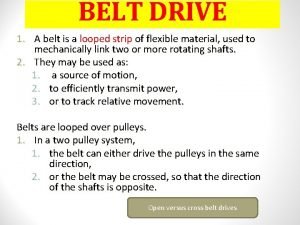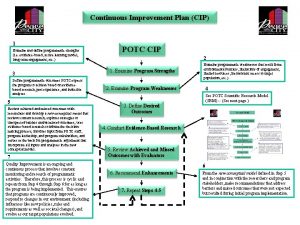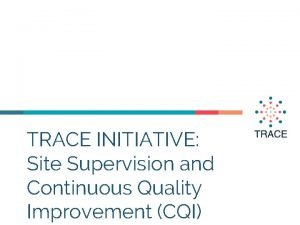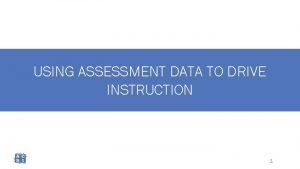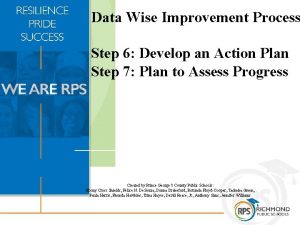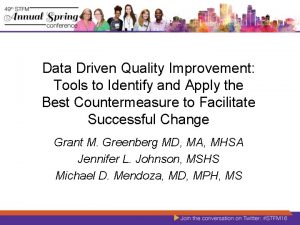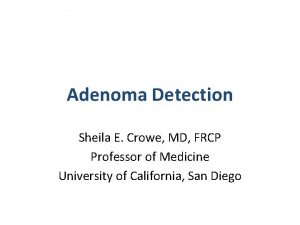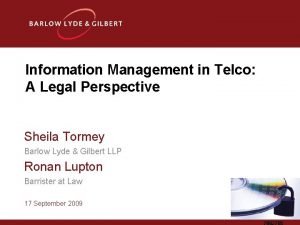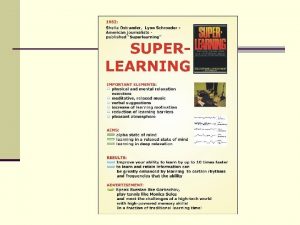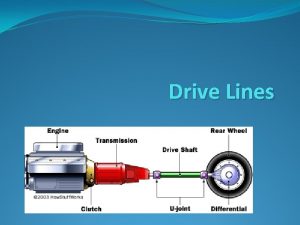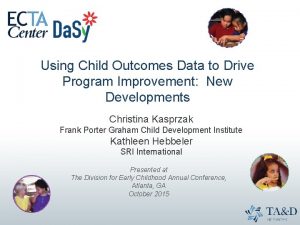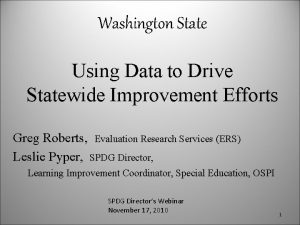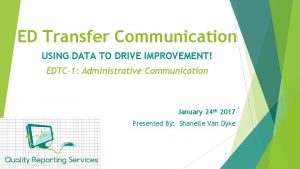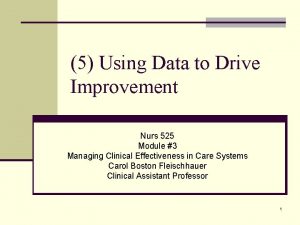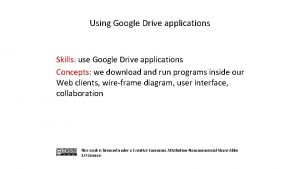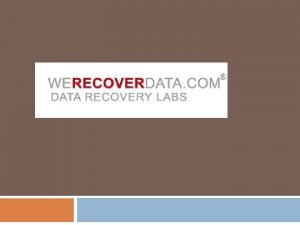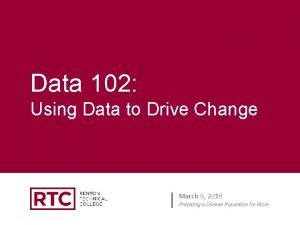Using Data to Drive AWD Program Improvement Sheila













































- Slides: 45

Using Data to Drive AWD Program Improvement Sheila Thompson, AWD Coordinator C-TEC of Licking County August 1, 2014

Data and Compliance What data do we already collect for our funding and accreditation agencies? – Perkins/OBR/HEI – Accreditation (ACCSC, COE) – State Agencies/Boards (Public Safety, COS, Medical Board) – Financial Aid (Title IV, Pell, Loans, ODJFS, VA, WIA)

Using the Data You Already Collect Which performance indicators are on target? – For Perkins/HEI/OBR? – For ACCSC/COE? – For state boards? Where are the data gaps? – By student, by program, and by CTPD What other information could inform improvement? – – Advisory Committee Recommendations Student satisfaction surveys Stakeholder and client surveys Instructors, Coordinators, FA and Student Services Staff

Comparison of Performance Standards Performance Standard Perkins/HEI/OBR ACCSC COE Work Keys 91% for CTPD N/A Aggregate by CTPD, 70% Report and Justify by Program 70% by Program Student Completion Retention or Transfer 83. 5% by CTPD Depends on program length 60% by Program Student Placement 79% Related OR Unrelated, by CTPD 68% RELATED ONLY, by Program 70% RELATED ONLY, by Program Technical Skill Attainment Credential, Certificate or License

Perkins/HEI/OBR Data • CTPD Level Data (aggregate) • Based on State/Federal Targets, with Local Targets “negotiated” each year – Technical Skill Attainment – Credential, Certificate or Degree – Student Retention or Transfer – Student Placement – Nontraditional Participation – Nontraditional Completion

ACCSC and COE Data • Program Level Data • Timelines based on program length and accreditation dates, NOT fiscal or calendar year • Retention and Placement based on Benchmarks, not Targets – Enrollment – Retention/Completion – Credentialing – Placement

CTPD vs. Program Data CTPD Data: Why: Drives Perkins/HEI/OBR performance and approvals Program Data: Why: Drives COE and ACCSC accreditation approvals Ability to collect/use: Easy to find, if not always timely Ability to collect/use: Can be difficult to collect, verify, analyze and improve over time Relevance: Difficult to analyze and act on beyond CTPD level Relevance: Most important data you can collect, analyze, and act on

Data and Improvement To what extent does our required data drive improvement? • Enrollment • Retention/Completion • Credentialing • Placement

Enrollment Data • Drives FTEs (AWD funding) • Drives Title IV and other FA resources • Becomes the starting point for your concentrators/completers • Used to evaluate program retention rates • Used in ED Gainful Employment Disclosures

Perkins/OBR Enrollment Data

HEI Enrollment Data


Factors Impacting Enrollment • • Marketing Program/Center Reputation Program Calendar, Length, or Design Enrollment Process – Prerequisites – High School Diploma/GED – Work Keys – Financial Aid Approval and Program Cost

Retention and Completion Data • FUNDING (Pell, Title IV, WIA) • Subject to ACCSC, COE Accreditation Benchmarks • Program Level is more important than CTPD level

Perkins Retention Data

CTPD Retention Data

HEI Completion Data by Area




Factors Impacting Retention and Completion – Satisfactory Academic Progress (SAP) • Attendance • Grades – Student Barriers (transportation, child care, conflicting work schedules, drug and alcohol use, mental illness) – Program/Instructor Issues – Leave of Absence (LOA) – Setting the bar too low for program enrollment

Credentialing Data • Perkins/HEI/OBR Performance Target • Accreditation Benchmark (COE, ACCSC) • Board/Agency Benchmark (Public Safety, State Medical Board, Ohio Dept. of Health) • Required or highly recommended for employment


Perkins Technical Skill Attainment Data

HEI Technical Skill Attainment Data

HEI Report Work Keys • Applied Math • Locating Information


Perkins Credentialing Data

HEI Credentialing Data

HEI Credentialing Data


COE Credentialing Chart

Credentialing: ACCSC

Factors Impacting Credentialing Rates • Misalignment between curriculum, instruction, and credentialing exam • Students refusing to take the exam • Students unable to take exam (criminal background, did not meet licensure requirements) • Student lacks required academic or technical skills • Inaccurate reporting • Access to exam results

Placement Data • Perkins, Accreditation, FA requirement • Used in ED Gainful Employment Disclosures • For Accreditation purposes, RELATED employment is more important than ANY OTHER PLACEMENT CATEGORY


Perkins Placement Data




COE Placement Chart

Factors Impacting Placement Rates Student Factors: – Did not pass required credentials – Employability skills (work ethic, personal barriers) – Lack of interest in related field School Factors: – Inconsistent or incomplete reporting – Lack of emphasis on follow up and placement services Labor Market Factors: – Industry demand/current openings in related field

Using the Data You Already Collect Which performance indicators are on target? – For Perkins/HEI/OBR? – For ACCSC/COE? – For state boards? Where are the data gaps? – By student, by program, and by CTPD What other information could inform improvement? – – Advisory Committee Recommendations Student satisfaction surveys Stakeholder and client surveys Instructors, Coordinators, FA and Student Services Staff

Implications for AWD Culture • More accountability by program and instructor • Better system for collecting, analyzing and acting on data • More frequent and deeper communication within and among program staff • Increased collaboration among intake, testing, instructional, financial aid, student services, and administrative staff • Action plans (Institutional Assessment and Improvement, CIP, CCIP) that are actually used and understood

Rewards for Using Data to Improve • More collaboration among staff • Fewer “findings” or “opportunities for improvement” • Improved programming and services for students • Improved relationships with external stakeholders • Move from “good” to “great”!
 Googlehttps://drive.google.com/drive/my-drive
Googlehttps://drive.google.com/drive/my-drive Googlehttps://drive.google.com/drive/my-drive
Googlehttps://drive.google.com/drive/my-drive Google doodle
Google doodle Cross belt drive
Cross belt drive 1https://drive.google.com/drive/u/1
1https://drive.google.com/drive/u/1 Http drive google com
Http drive google com Difference between belt drive and chain drive
Difference between belt drive and chain drive Comait
Comait Cip 1
Cip 1 Airport improvement program aip
Airport improvement program aip Continuous quality improvement program planning worksheet
Continuous quality improvement program planning worksheet Missippi's literacy program shows improvement
Missippi's literacy program shows improvement Profit improvement program
Profit improvement program Productivity improvement program
Productivity improvement program Using assessment to drive instruction
Using assessment to drive instruction Data wise meeting norms
Data wise meeting norms Data driven quality improvement
Data driven quality improvement The bass the river and sheila mant characters
The bass the river and sheila mant characters Dr sheila crowe
Dr sheila crowe El novio de la muerte acordes
El novio de la muerte acordes Sheila eyberg
Sheila eyberg Greibach normalform
Greibach normalform Sprachfamilien baum
Sprachfamilien baum Sheila ortega nacimiento
Sheila ortega nacimiento Sheila garcia perez
Sheila garcia perez Bentuk normal greibach
Bentuk normal greibach Summary of an inspector calls
Summary of an inspector calls Lamar gant
Lamar gant Clothes mean something quite different to a woman
Clothes mean something quite different to a woman How does sheila change in an inspector calls
How does sheila change in an inspector calls Polyp
Polyp Sheila has just arrived at the airport and is dragging
Sheila has just arrived at the airport and is dragging Sheila gupta
Sheila gupta Sheila embleton
Sheila embleton Sheila bouman
Sheila bouman Meet kevin henkes
Meet kevin henkes Sheila tormey
Sheila tormey Tyrone from bronx masquerade
Tyrone from bronx masquerade Sheila's community learning curve
Sheila's community learning curve Sheila ostrander and lynn schroeder
Sheila ostrander and lynn schroeder Sheila harshey
Sheila harshey Sheila
Sheila Sheila is writing a persuasive message
Sheila is writing a persuasive message Double meaning story
Double meaning story Searching for sheila
Searching for sheila Frances baillon
Frances baillon



